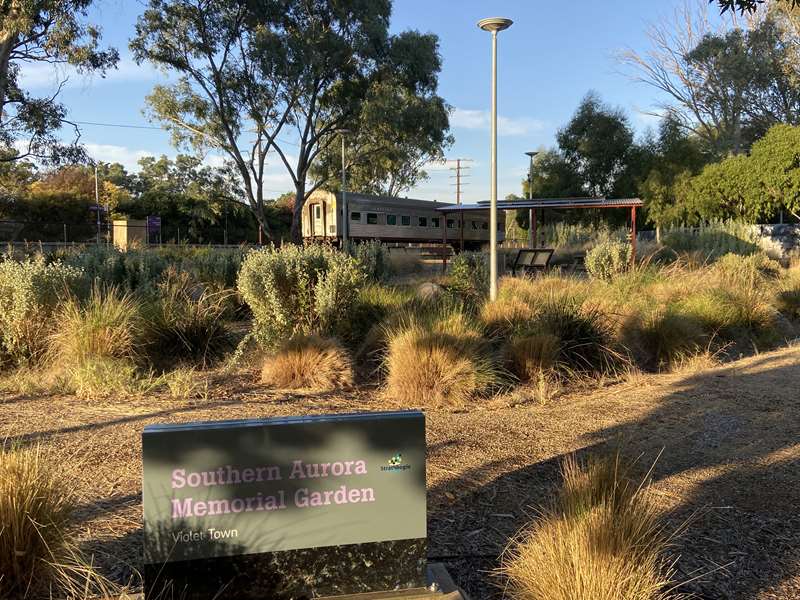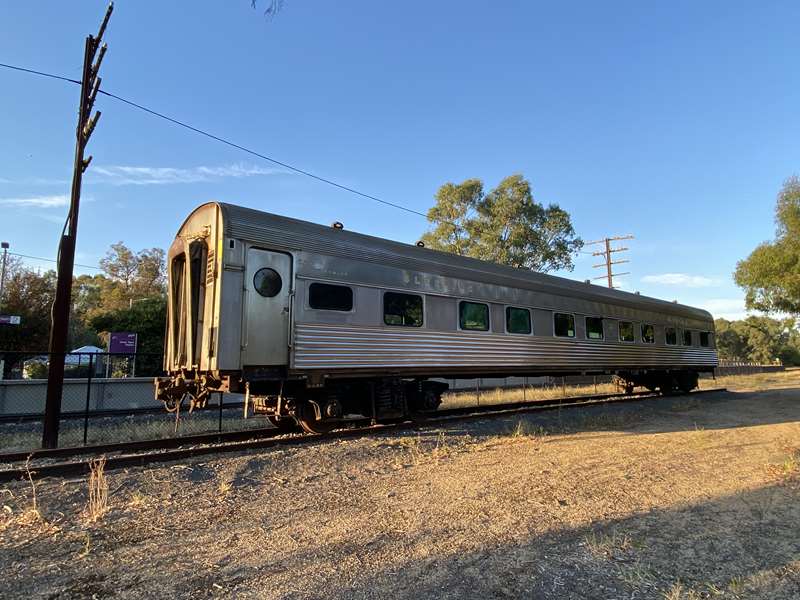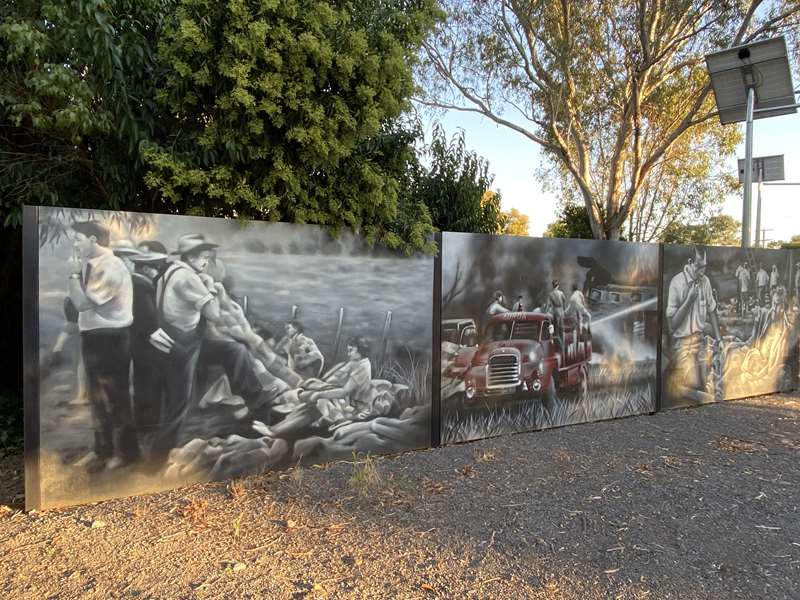Violet Town - Southern Aurora Memorial Gardens


The Southern Aurora Memorial Garden commemorates the tragic 1969 rail accident on the outskirts of town.
It has an award winning exhibition, murals, meditative garden, information boards, Aurora carriage, shade, seats, shelter, water tap and BBQ.

The commemoration gardens has an overall theme of Helping Hands. It is a way of signifying how people stepped forward to help each other, whether women or men, staff or passengers, whether voluntary or paid, or whether local or from far away. Everyone did what they could.
It is hoped the gardens area can be a place of reflection, calm, remembering and acknowledgment into the future.

One of the key highlights of the garden area is embedding of words within the surface of curving and inter-twining pathways. The words to be embedded are positive human attributes displayed on the day of the tragedy like: courage, hope, love, generosity, kindness.
There is a 2.79km Southern Aurora Memorial Walk encompassing this area.
The Southern Aurora - Violet Town tragedy
By BRUCE CUMMING FRIDAY
February 7, 1969 is a date seared into the memory of many people.
The sun had not long risen over a dry landscape after a hot night, and there was not a cloud in the sky nor a movement of wind.
At 7am the people of the northeast were starting their normal day rising, eating breakfast, getting ready for work or preparing for school.
Some had already started work to get things achieved before the heat of the day arrived.
Some people could hear the famed Southern Aurora overnight express train speeding through the town southwards to Melbourne.
The passengers from all over Australia and overseas and the crew were starting their day in a similar way to the locals, with carriages taking turns for passengers to get breakfast in the dining car.
But it was to be far from a normal day.
The terrible sounds, over several seconds, of the shiny sleeper train colliding head-on into a goods train were heard for miles.
Carriages full of passengers shot over the impact zone, others crumpled in a tangled pile-up.
Across their paddocks Glad and Alan Walter were shocked to see the horrific scene, as the trains hit at high speed and carriages arched up into a pyramid.
Alan like so many others in the district rushed to the scene to help.
People arrived at the scene by car, bicycle, and tractor to help. Violet Town's urban and rural fire-trucks arrived quickly on the western side of the crash zone on the level crossing 900 metres south of the town.
Black smoke billowed from burning fuel under the wreckage, and a ribbon rose high into the sky. On the eastern side passing cars and trucks pulled up and drivers from Queensland, NSW and Milawa ran to help.
The first private fire unit to arrive on the eastern side was a farm ute driven by John Dugdale suppressing a grass fire spreading from the crash.
The Euroa fire-truck soon arrived and the men commenced I breaking the strong plexiglass windows with a small axe, rescuing people, and dousing the ongoing fires around the smashed locomotives. It was one of the first times that fire-fighting foam had been used.
On the western side a similar process was taking place.
Reg Crosier had landed his super-spreader plane in a paddock, and with his mate Norm Cowan used the plane's fire-axe to break windows, while previous attempts to break them had mixed success.
That was the start of a long and very difficult day for the 220 people on the train and also for the many hundreds of people who made themselves available to do a range of tasks including, communications, rescue, fire-fighting, welfare, nursing, transport, protecting peoples belongings, first aid, police work, and ambulance.
Dr Dunn from Euroa managed the medical needs at the crash site, while at the Violet Town hall Dr Kirkwood and local nurses managed a medical clearing station.
Many other volunteers and services were mobilised around the region to help including Red Cross, St John and Civil Defence and undoubtedly saved many lives. By the end of that long day over 120 passengers and crew were to be officially listed as physically injured.
Nine died, and untold damage was done.
Many helpers were also injured and greatly affected by the incident.
The subsequent enquiries found that those killed died by misadventure triggered by the heart attack of the Aurora driver, whose train jumped the points of the Violet Town passing loop and continued on to cause the devastating collision.
Remembering their roles
BY GRACE EVANS
AS the sounds of a horrific train crash echoed from Violet Town on the morning of February 7, 1969, several people were quick to rush to the aid of passengers on board.
Among those were First Constable Jack Knowles, the only policeman in Violet Town at the time, who was later awarded the British Empire Medal for his efforts in directing the rescue and salvage operation.
Mr. Knowles' daughter Jacqui Penman was getting ready for school at the time of the crash, saying once he got that phone call he was off and we didn't really see him for the next few days.
"We went outside and I can just remember it was like an atomic bomb it was this big thing of smoke," Mrs. Penman said.
As the commemoration nears Mrs. Penman said her father would've given these people who have coordinated it all a big pat on the back.
"He would've known those people as kids growing up and would be stoked at the amount of effort that has gone into it," she said.
Dr Robert Dunn also played a pivotal part in the survival of many, as the first and only doctor on site he worked tirelessly to help remove those stuck in the carriages.
Patients were later transported to the Euroa Hospital where Dr Alan Waterhouse tended to the injured.
His son James Dunn re-calls a story where his father was able to get in underneath someone trapped and hunch his back just enough to re-lease someone's toe, without it having to be amputated.
Mr. Dunn admits his father was a "keep to himself" sort of person and didn't make any fuss about any of his heroic actions.
"Those people of Dad's era their army training would've kicked in as they crawled through those carriages," Mr. Dunn said.
"He was a very humble man but I do know when he received his Order of British Empire medal he was very proud."
Mr. Dunn said his father would've been all for the memorial gardens and would've probably been on the committee if he had have been here.
"He would've felt very strongly that such a thing should be remembered," Mr. Dunn said.
Crawling alongside Dr Dunn was Terry Brodie, who at the time was 25 and belonged to the Euroa Fire Brigade.
He vividly remembers the strewn mail that lay aside the tracks as people hurried to others rescue.
"What Dr Dunn was able to do at the time was actually unbelievable," Mr. Brodie said.
"It was a stinking hot day and he just went right in and getting right down in the carriages to help people."
A time to remember
With the Southern Aurora sleeper carriage delivered, the gardens, exhibitions, and information boards ready, the town hosted over 3000 people across the 4 days.
In 1969 local volunteers and emergency services were pivotal in helping survivors to escape and gain first aid and many types of support. Over 50 years later locals, survivors, families and the general public vividly remember the fateful day. Many of those attended the commemoration.
The new gardens area and events were the result of the work of a group of locals to respectfully acknowledge the tragedy. Southern Aurora Memorial Committee member and Aurora historian Bruce Cumming said the community welcomed people from across Australia with a connection to the tragedy.
An early morning vigil service was led by Rev Michele Wood on the Thursday, at the time of the collision. "300 people came to collectively and individually gather their thoughts and memories of the tragedy at the crash site" Mr Cumming said. 'The 4 day commemoration was all about remembering those who died, those who were injured physically and psychologically, and thanking those who bravely and generously did all they could to save lives and support people."
The weekend featured art and museum exhibitions, a vintage emergency vehicles parade, a night concert headlined by the Choir of Hard Knocks and the renowned monthly market. The "helping hands" memorial gardens was launched by Jaclyn Symes MLC recognising the deep significance of the tragedy to responders, helpers, victims and families. 2000 people listened as Ian Macdougal from Canberra sang a tribute called "Violet Town" he wrote in 1970 about the community response. A community art activity where people wrote personal and poignant messages on coloured paper hands and planted them in the new garden was a highlight.
Mayor Amanda McClaren said Council was honoured to support such an important commemorative event. "The Southern Aurora Memorial Garden acknowledges those whose lives were forever changed by this tragedy and its aftermath, and will serve as a reminder of the strength of community in overcoming adversity."
The Violet Town community raised significant funds, and was helped by $50,000 from Strathbogie Shire Council, $150,000 from the Victorian Government, $13,000 from the Australian Government $16,500 from ARTC and VLine donated the carriage. Many individuals gave their time, ideas, funds, materials and labour, and many community groups and businesses also contributed.
The project work is continuing to restore the carriage, grow the garden, build the exhibition and honour the people associated with the tragedy and any assistance is appreciated. There are many individual stories out there, and the committee would appreciate any information related to the crash.
Photos:
Location
14 Cowslip Street, Violet Town 3669 Map
✆ 0419 540 552
Web Links
→ www.southernauroraviolettown.com.au
→ Southern Aurora History Violet Town on Facebook
→ Southern Aurora Memorial Walk (Walking Maps)











